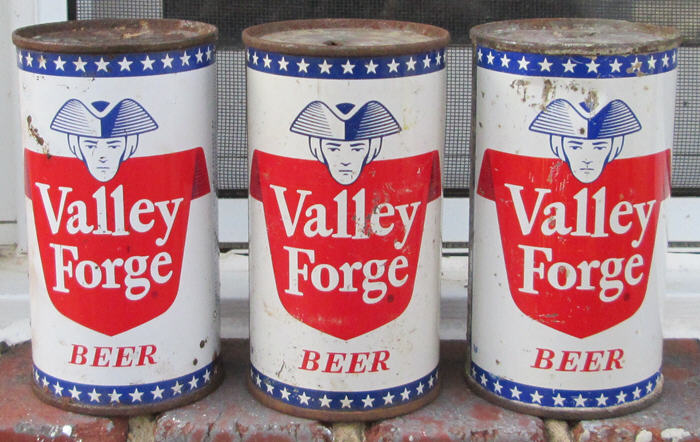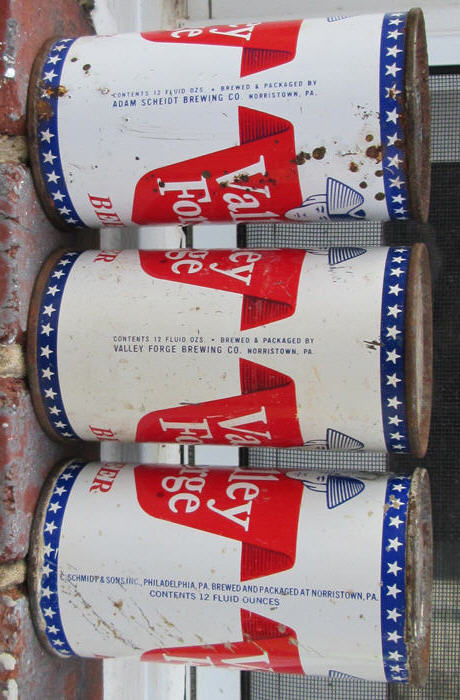Valley Forge White Flats: 1961-1963
 |
This month let's look at three very similar cans. There are some small differences in the shading, but that's not why most collectors would consider them different cans. They're different because even though they were all produced by the same company at the same brewery, they each come from a different brewery. Huh? What? Let me explain.
The can on the left is from Adam Scheidt Brewing.
The can in the middle is from Valley Forge Brewing.
The can at right is from C. Schmidt Brewing.
Take a look at the side seams where the brewery is listed. (I rotated the photo to make it easier to read.
 |
Despite the brewery listed on the side, it was all the same company. And that is the theme of this month's Can-of-the-month, DBA's, "Doing Business As."
DBA's
I mentioned DBA's earlier with my April 2009 COM, a Hals Beer which was made by Globe Brewing but supposedly came from Hals Brewing. Hals was another company name used by Globe. As I noted on that page, A DBA brewery uses a different name from the recognized, legal name of the business. Lots of breweries used such assumed names and many still do. The cans of Blue Moon in my refrigerator say they were made by the “Blue Moon Brewing Company” which is really Molson-Coors.
Why would companies use a DBA? There are many reasons.
Sometimes it involves a franchise where a particular company owns a series of businesses using a franchised name, such as Smith & Smith, LLC operating a number of "Bob's Famous Chicken" restaurants.
For breweries a DBA is useful to hid a relationship from the average consumer. A huge brewing company might create a brand using a DBA so that consumers who did not want to buy products from Gigantic Brewing might be willing to buy beer from "Bobby's Brew" not knowing that the latter was made by the former.
A brewery might use a DBA to deal with a negative reputation. Globe may well have created Hals Brewing because Globe had been around a very long time, had an established reputation, and by creating Hals as a DBA, could market to consumers who had already made up their mind that they did not like Globe's products.
In the case of the Valley Forge cans, the names reflected the purchase of a small brewery by a larger one. C. Schmidt of Philadelphia purchased the much smaller Adam Scheidt Brewing of Norristown in 1954. Adam Scheidt made good beer. Their Rams Head Ale and Valley Forge were very popular in the DC and the surrounding areas in Maryland and Virginia. So by keeping the original company's name the new owners could continue to benefit from the customer loyalty Adam Scheidt had accumulated.
In December 1962, however, they began using the Valley Forge name. I have not yet discovered why. Had it been long enough (eight years) that the Adam Scheidt name no longer had much benefit for customer recognition? For whatever reason, the switch was made to "Valley Forge Brewing" but that name was short-lived. It was abandoned in November 1963. At that point Valley Forge (and Rams Head Ale) were packaged under the C. Schmidt brewery name. Hence we have the three cans shown above, all with the same label except for the brewery name on the side.
Note; These cans came out the same time that flat top cans were replaced by the first pull tabs, the "zip top," so the Valley Forge zip top comes in both the Valley Forge Brewing and C. Schmidt brewing variations. Check my Zip Top page for more about that switch.
For More on Adam Scheidt please see the pages lsited below.
Valley Forge Bock: August 2005
